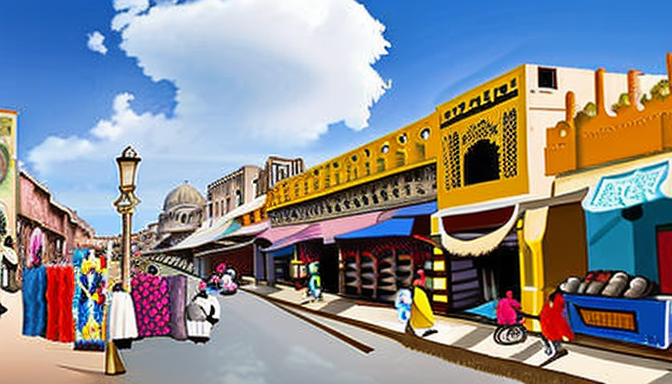Karachi is not just a city; it’s a living tapestry woven with the threads of countless stories. Each street corner, every bustling market, whispers tales of the past. When you walk through the city, do you ever wonder about the lives that shaped it? The vibrant history is painted in the faces of its people, each with their own unique narratives. Listening to those who have witnessed Karachi’s evolution is like opening a treasure chest filled with memories.
Imagine sitting down with an elder, perhaps sipping chai, as they recount their experiences. They speak of a time when Karachi was a small fishing village, where the sea was the lifeline. Fast forward to today, and you see a sprawling metropolis that has embraced change yet clings to its roots. This juxtaposition is what makes Karachi so special. The stories of resilience and adaptation are not just historical; they are a part of our everyday lives.
Many of these stories are captured in interviews and oral histories. These voices help us understand the socio-political shifts that have shaped the city. From the partition of India to the influx of diverse communities, each event has left an indelible mark. It’s essential to listen and learn from these accounts. They remind us that every brick has a story, every alley a memory. So, next time you stroll through Karachi, take a moment to listen. You might just hear the echoes of the past calling out to you.
Historical Landmarks and Their Significance
Karachi is a city that whispers secrets through its historical landmarks. Each site tells a story, a piece of the puzzle that forms the rich tapestry of this vibrant metropolis. Imagine walking through the streets of Frere Hall, where the echoes of colonial times still linger. This stunning structure, adorned with lush gardens, has witnessed countless events that shaped the city. It’s not just a building; it’s a silent witness to Karachi’s evolution.
Then there’s the Mohatta Palace, a gem of architecture that reflects the dreams of its creators. Built in the 1920s, it stands as a testament to the artistic vision of its time. Visiting this palace is like stepping back into history, where every corner has a tale to tell. Have you ever wondered what it was like to host a grand party there? The laughter and music must have filled the air!
Let’s not forget the Quaid-e-Azam’s Mausoleum. This grand structure is not just a resting place for the founder of Pakistan; it’s a symbol of hope and aspiration. People from all walks of life come here, paying their respects and reflecting on the past. It serves as a reminder of the struggles and triumphs that defined a nation.
These landmarks are more than just stones and bricks. They are the memories of those who walked before us. Listening to stories from the elders, who witnessed Karachi’s transformation, adds depth to our understanding. They share tales of joy, sorrow, and resilience. Each narrative enhances our connection to the city.
In a way, Karachi’s historical landmarks are like old friends. They hold memories, share wisdom, and invite us to explore the past. So, next time you stroll through the city, take a moment to pause. Listen closely, and let the stories of these sites resonate within you.

Cultural Influences and Their Legacy
Karachi is not just a city; it’s a tapestry woven with countless threads of culture, history, and identity. Each community that has settled here has left a mark, a legacy that shapes the city today. Imagine walking through the bustling streets, where the aroma of spices mingles with the sounds of laughter and chatter in various languages. This is Karachi—a melting pot of traditions.
Listening to the stories of those who’ve lived here for decades is like opening a treasure chest of memories. They share tales of how their ancestors arrived, bringing with them customs, cuisines, and languages. For instance, the influence of the Sindhi culture is evident in the vibrant festivals celebrated throughout the year. The Mohajir community has also played a significant role, introducing unique culinary delights that have become local favorites.
These cultural influences are not just remnants of the past; they are alive in the city’s pulse. Take a stroll through Burns Garden or visit the Mohatta Palace, and you’ll see how history and culture coexist. The architecture tells stories of a bygone era, while the people breathe life into these structures. The legacy of Karachi’s diverse communities continues to resonate in art, music, and daily life, creating a colorful mosaic that reflects both the struggles and triumphs of its residents.
So, what does this mean for Karachi today? It means a city rich in diversity and resilience. It’s a reminder that every story matters, and every voice contributes to the greater narrative of this vibrant metropolis. The echoes of the past are not just whispers; they are a chorus that shapes the future.
Frequently Asked Questions
- What are some must-visit historical landmarks in Karachi?
Karachi is home to several historical landmarks like the Quaid-e-Azam’s Mausoleum, Mohatta Palace, and Frere Hall. Each of these sites tells a unique story about the city’s past and its cultural evolution.
- How have different cultures influenced Karachi?
The city is a melting pot of cultures, with influences from Sindhi, Balochi, Punjabi, and Mohajir communities, among others. This rich tapestry of cultures is reflected in the city’s festivals, cuisine, and everyday life.
- Why is it important to explore Karachi’s untold stories?
Exploring these untold stories helps us understand the socio-political changes that have shaped Karachi. It allows us to appreciate the resilience and diversity of its people, making the city more than just a geographical location.
- Are there any tours available that focus on Karachi’s history?
Yes! There are various guided tours that focus on Karachi’s historical sites and cultural stories. These tours provide a deeper insight into the city’s past and are perfect for history enthusiasts.